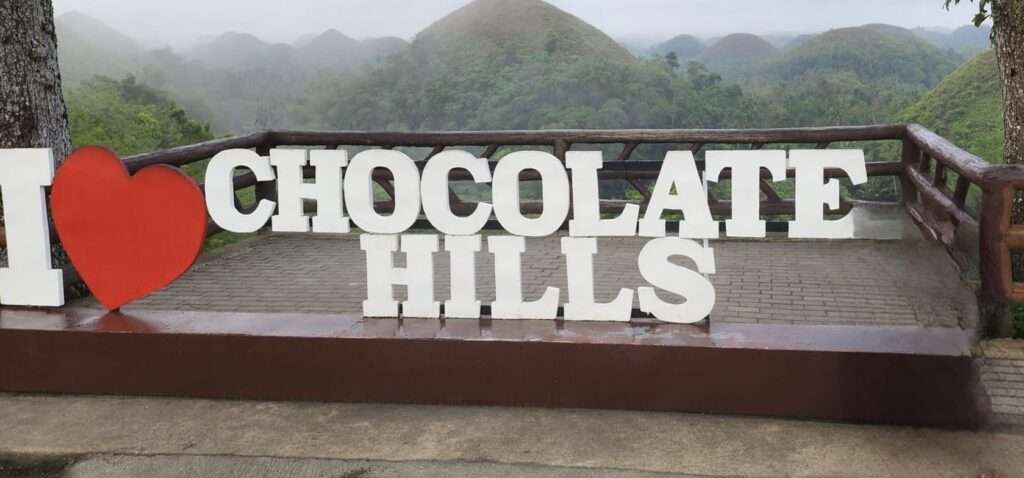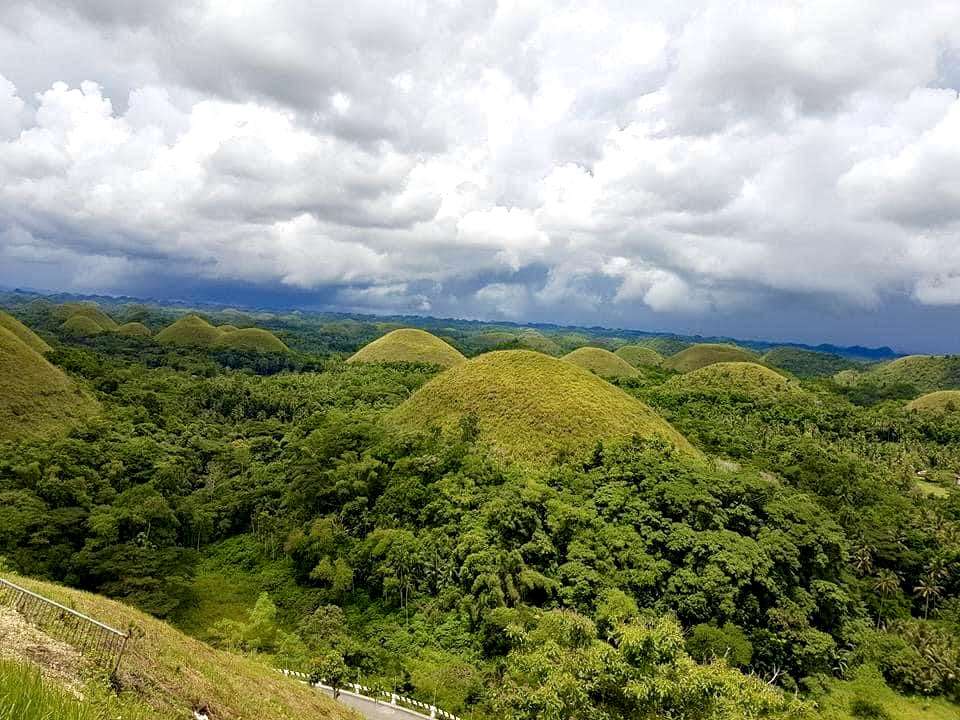Overview of Chocolate Hills
The Chocolate Hills in Bohol are a geological marvel and a national symbol of the Philippines. Spread over 50 square kilometers across the towns of Carmen, Bilar, Sagbayan, and Batuan, these unique formations number anywhere between 1,260 and 1,776 hills depending on the survey.
Each hill is almost perfectly symmetrical, ranging between 30 and 120 meters in height. During the dry season, the grass covering the mounds turns from lush green to rich brown, creating the impression of thousands of giant chocolate drops sprinkled across the countryside.
The Chocolate Hills are not only a stunning sight but also a symbol of Bohol’s natural and cultural heritage:

Characterized by their almost symmetrical mound shapes, the hills range from 30 to 120 meters in height. The hills sprawl over the towns of Bilar, Carmen, and Sagbayan, among others.
On my last visit, I climbed the viewing deck in Carmen early in the morning. The rising sun bathed the hills in golden light, and the view of endless “chocolate mounds” fading into the horizon was unforgettable.
As a distinctive natural marvel, the Chocolate Hills have been designated a national geological monument and proposed for inclusion in the UNESCO World Heritage list.
- Vegetation: Primarily grass-covered
- Seasonal Change: Grass turns brown in the dry season
The formation’s origin remains a subject of debate among scientists, with theories including oceanic volcanic eruptions, uplift of coral deposits, and a combination of erosion and weathering of limestone.
Activities: The site attracts numerous visitors for activities such as sightseeing and photography, especially during the dry months when the hills are most reminiscent of chocolate.
Significance: Recognized as a Philippine National Geological Monument, the Chocolate Hills embody not only a unique natural phenomenon but also cultural significance, adding to the rich heritage of the Philippines.
My view from the top of Chocolate Hills in Bohol was like something out of a storybook! All these hills around me, looking like big chocolate kisses. The sun shone down, bathing them in warmth, making them shine and sparkle. I have to say, being there, it just made me feel so calm and content. It was like a reminder that sometimes, the simplest stuff can be the coolest.

Table of Contents
Geology and Formation
The Chocolate Hills of Bohol are a prime example of a geomorphological wonder, born from extensive geological processes that sculpted the landscape into a field of uniform conical mounds.
Coral Deposits and Erosion
Geologists attribute the formation of the Chocolate Hills to the uplift of coral deposits and the action of rainwater erosion. These structures are remnants of limestone from ancient reefs that were pushed upward from the sea floor, forming the bedrock of the hills we see today.
The intense weathering processes and eroding power of rainwater then gradually shaped these limestone blocks into distinctive conical forms.
- Coral Deposits: Foundation of grass-covered limestone hills.
- Erosion: Sculptor of the unique conical hills.
Unique Landscapes
The topography of the Chocolate Hills is classified as kegelkarst, a type of landscape characterized by isolated, steep, and often conical limestone hills.
The hills exhibit a striking uniformity in shape and vary in height ranging from 30 to 120 meters. The green grass that covers these hills turns brown during the dry season, resembling vast rows of chocolate ‘kisses,’ which highlights why the term “Chocolate Hills” became synonymous with this geological formation.
- Kegelkarst Topography: Uniform and iconic conical hills.
- Visual Aspect: Seasonal transformation of grass-covered hills adding to the spectacle.
Tourist Information
Visitors to Bohol’s Chocolate Hills can look forward to an array of activities and scenic viewpoints, particularly during the dry season which offers optimal conditions for exploration and sightseeing.
Best Time to Visit
The dry season, typically spanning from December to May, is the best time to visit the Chocolate Hills. With minimal rainfall, the iconic hills flaunt their distinctive chocolate brown color, offering tourists a picturesque landscape. April is especially recommended for the least chance of rain.
Viewing Decks and Observation Areas
To fully appreciate the grandeur of the Chocolate Hills, tourists are advised to visit established viewing decks and observation areas.
Two popular spots are:
- Chocolate Hills Complex: Featuring a main observation deck, this site provides a 360-degree view of the hills.
- Sagbayan Peak: Another extensive viewpoint which also includes facilities like a souvenir shop for tourists to purchase keepsakes.
Activities and Experiences
A variety of activities keep tourists entertained beyond simple sightseeing. Some highlights include:
- Chocolate Hills Adventure Park: Offers a thrilling zipline experience across the hills.
- ATV Rides: Chocolate Hills ATV rental services enable visitors to climb and explore the hills in a more adventurous manner.
- Guided Tours: Guided tours are available, which provide insightful background on this spectacular tourist attraction and ensure tourists have a fulfilling experience.
Access and Transportation

Getting to and moving around the Chocolate Hills in Bohol involves a combination of air, sea, and land transportation, with several options available for both international and local travelers to reach this natural wonder.
Local Travel Options
From Tagbilaran to Chocolate Hills:
- Buses: Travelers can board a bus at the Dao Integrated Bus Terminal in Tagbilaran City. The fare typically ranges from PHP 60-80. The journey to the Chocolate Hills may take approximately 2 hours.
- Vans: Vans for hire, often referred to as V-Hires, offer a faster but slightly more expensive alternative to buses.
- Motorbike Rentals: For the adventurous, renting a bike, scooter, or a motorcycle known as ‘habal-habal’ in local parlance allows personalized travel schedules and the freedom to explore nearby attractions such as Sagbayan, Bilar, and Batuan.
Within Bohol:
- Tricycles: For short distances within towns like Carmen, tricycles are a convenient option.
- Private Cars: Renting a car provides comfort and flexibility for those planning to visit multiple sites in a day.
Arriving from Nearby Cities
From Manila:
- Air: Daily flights are available from Manila to the Bohol-Panglao International Airport in Panglao. From there, travelers can hire a van or a taxi to reach the Chocolate Hills.
- Sea: Alternatively, sea travel from Manila to Tagbilaran City Seaport via ferry is an option, followed by a bus or van ride to the hills.
From Cebu:
- Sea and Land: There is no direct ferry service to Chocolate Hills. However, one can take a ferry from Cebu to Tagbilaran City Seaport, followed by a bus or a van to the Chocolate Hills.
From Siquijor:
- Sea: Siquijor to Bohol ferries arrive at Tagbilaran, offering travelers the option to transfer to buses or vans that drive to the Chocolate Hills area.
Check the latest schedules as timings and availability of services may vary seasonally.
Accommodations and Facilities
Visitors to the iconic Chocolate Hills in Bohol have a diversity of accommodations to choose from, ranging from hotels and resorts to more rustic and eco-friendly options. Many of these places offer dining facilities, ensuring a convenient and comfortable stay.
Hotels and Resorts
Bohol Island provides a range of hotels and resorts catering to various preferences and budgets.
For instance, Villa del Carmen Haven Bohol is known for its affordability and provides guests with essential amenities like a swimming pool and an on-site restaurant.
Travelers seeking proximity to the Chocolate Hills might opt for hotels such as those within a 0.33-mile radius of the Chocolate Hills Complex, offering scenic views and ease of access to the natural monument.
- Jolits Ecogarden Integrated Farm: Situated 8.1 miles from the Chocolate Hills, this farm stay blends accommodations with natural surroundings.
- LHOYJEAN Garden Hostel: A hostel choice for travelers, offering dormitory-style rooms and communal spaces like a garden and lounge.
Facilities like conference rooms and activity areas are available at several larger resorts, making them suitable for both leisure and business trips.
Dining Options
Dining options in the vicinity of the Chocolate Hills vary from in-hotel restaurants to standalone eateries that serve local and international cuisine.
Resorts typically feature their own restaurants that provide guests with the convenience of on-site dining.
For those exploring the Chocolate Hills Complex, there are nearby options that allow for a quick meal in between sightseeing.
- Hotel Restaurants: Hotels like Villa del Carmen Haven Bohol offer dining facilities, where guests can enjoy meals without leaving the premises.
- Local Eateries: Independent restaurants and local food joints offer visitors a taste of Bohol’s culinary delights, often featuring fresh, regional ingredients.
Conservation and Community
The Chocolate Hills of Bohol are a prime example of the intricate balance between conservation efforts and community involvement. Their preservation is crucial not only for ecological reasons but also for the social and economic well-being of local communities.
Environmental Efforts
Bohol Island, as part of the UNESCO Global Geopark, highlights the preservation of the Chocolate Hills.
This geological marvel faces challenges due to human activities, such as unregulated tourism developments.
Conservation initiatives are therefore implemented to maintain the delicate karst landscapes that form this natural wonder.
Ecotourism
Tourism, if managed responsibly, has the potential to support environmental preservation efforts by providing economic incentives for conservation.
Local establishments are encouraged to seek accreditation to ensure they adhere to ecological best practices, which in turn, protects the area’s exceptional geological formations and promotes sustainable tourism.
Wildlife Protection
Another facet of conservation on the island involves the protection of endemic species, like the Philippine tarsier.
Sanctuaries contribute to the conservation of these vulnerable primates while allowing tourists a glimpse into their world without disrupting their natural habitat.
Community Involvement
The link between the Loboc River and local livelihoods reflects Bohol’s broader conservation strategy.
Communities are engaged in maintaining the river’s health, understanding that it is intrinsically connected to the overall ecological integrity of Bohol Island.
Through concerted efforts, Bohol demonstrates that conservation and community development can co-exist. This ensures the environment thrives alongside economic growth.
Frequently Asked Questions
This section addresses common inquiries about their formation, tourist activities, historical context, significance to tourism, entrance fees, and navigation advice.
How were the Chocolate Hills formed?
The Chocolate Hills are thought to be the result of thousands of years of weathering of marine limestone. They get their name from the brown grass that covers the hills during the dry season, giving them a chocolate-like appearance.
What activities can tourists enjoy in the Chocolate Hills?
Tourists can engage in activities such as sightseeing, photography, and ATV rides.
During the dry season, the famous hills’ chocolate brown color makes for a spectacular landscape perfect for exploration.
Can you provide historical context about the Chocolate Hills?
The Chocolate Hills have been a prominent feature of local legend, with several stories explaining their origin. They are also a significant physical landmark that has played a role in the cultural identity of Bohol province.
What is the significance of the Chocolate Hills to Philippine tourism?
They are a symbol of natural beauty in the Philippines and a key draw for tourists to the Bohol region. The site is often featured in promotional materials for Philippine tourism, showcasing the country’s unique natural attractions.
Is there an entrance fee to visit the Chocolate Hills, and if so, how much is it?
There is an entrance fee for visitors to access Chocolate Hills viewing areas, though the exact fee may vary. Visitors should check the latest rates and possible changes ahead of their visit.
How can visitors best navigate the Chocolate Hills area?
To navigate the Chocolate Hills area effectively, visitors can use local tour guides or rent motorbikes. The roads are well-signed, making self-guided tours possible for the more adventurous traveler.
